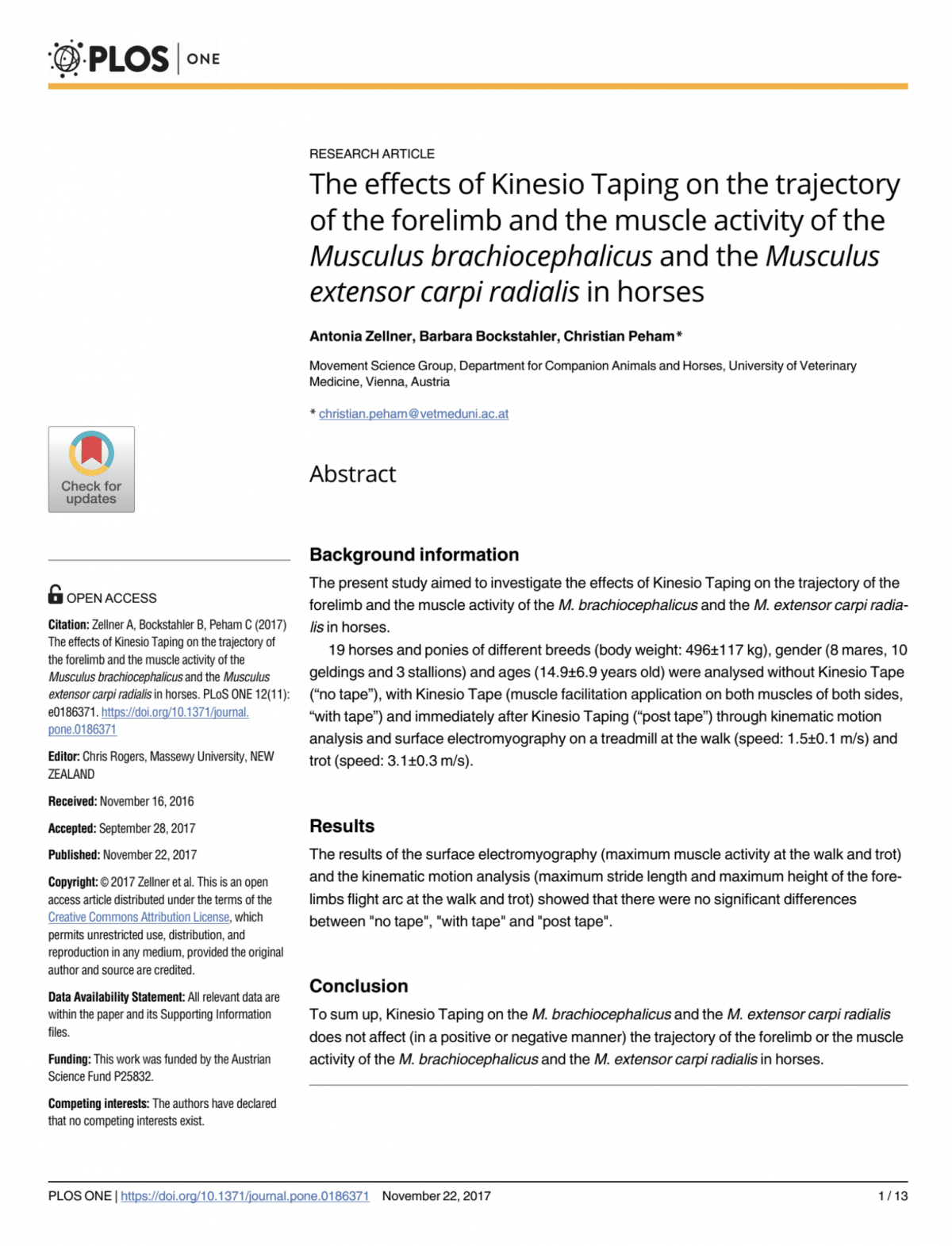The effects of Kinesio Taping on the trajectory
of the forelimb and the muscle activity of the
Musculus brachiocephalicus and the Musculus
extensor carpi radialis in horses
Antonia Zellner, Barbara Bockstahler, Christian Peham* christian.peham@vetmeduni.ac.at
Abstract
Background- The present study aimed to investigate the effects of Kinesio Taping on the trajectory of the forelimb and the muscle activity of the M. brachiocephalicus and the M. extensor carpi radialis in horses. 19 horses and ponies of different breeds (body weight: 496±117 kg), gender (8 mares, 10 geldings and 3 stallions) and ages (14.9±6.9 years old) were analysed without Kinesio Tape ªno tapeº), with Kinesio Tape (muscle facilitation application on both muscles of both sides, ªwith tapeº) and immediately after Kinesio Taping (ªpost tapeº) through kinematic motion analysis and surface electromyography on a treadmill at the walk (speed: 1.5±0.1 m/s) and trot (speed: 3.1±0.3 m/s).
Methods/Materials-This animal experiment was approved by the Ethics Committee of the University of Veterinary Medicine, Vienna (Reference: 68.2505/0160-II/36/2012) and the permissions from the owners to use the horses and ponies exist (S1 Appendix). A power analysis was performed to determine the sample size. The power analysis was conducted in G-POWER using an alpha of 0.05, a power of 0.80 and an effect size of 0.4. Based on the aforementioned assumptions, the required sample size was determined to be 15. Therefore, 19 horses and ponies of different breeds (body mass: 496±117 kg), gender (8 mares, 9 geldings and 2 stallions) and ages (14.9±6.9 years old) were used in this study. The horses were clinically free of lameness. 8 of them were show horses (Pony Mounted Games and eventing horses), also used for training of riders on basic to advanced levels in a riding school, and 11 of them were from the teaching herd of the University for Veterinary Medicine Vienna. All of them were accustomed to the experimental set-up on the treadmill (Mustang 2200)1. The horses were accommodated in an own stall in the stable of the University of Veterinary Medicine Vienna for one to two days while their measurements were taken. During their stay they got hay and water ad libitum and their common concentrated feeding stuffs. This animal experiment was approved by the Ethics Committee of the University of Veterinary Medicine, Vienna (Reference: 68.2505/0160-II/36/2012).
Results-The results of the surface electromyography (maximum muscle activity at the walk and trot) and the kinematic motion analysis (maximum stride length and maximum height of the forelimbs flight arc at the walk and trot) showed that there were no significant differences between “no tape”, “with tape” and “post tape”.
Conclusion-To sum up, Kinesio Taping on the M. brachiocephalicus and the M. extensor carpi radialis does not affect (in a positive or negative manner) the trajectory of the forelimb or the muscle activity of the M. brachiocephalicus and the M. extensor carpi radialis in horses.
Keywords- Electromyography, horse, Kinesio Tape, Tape with wisdom Kinesio live different science.



